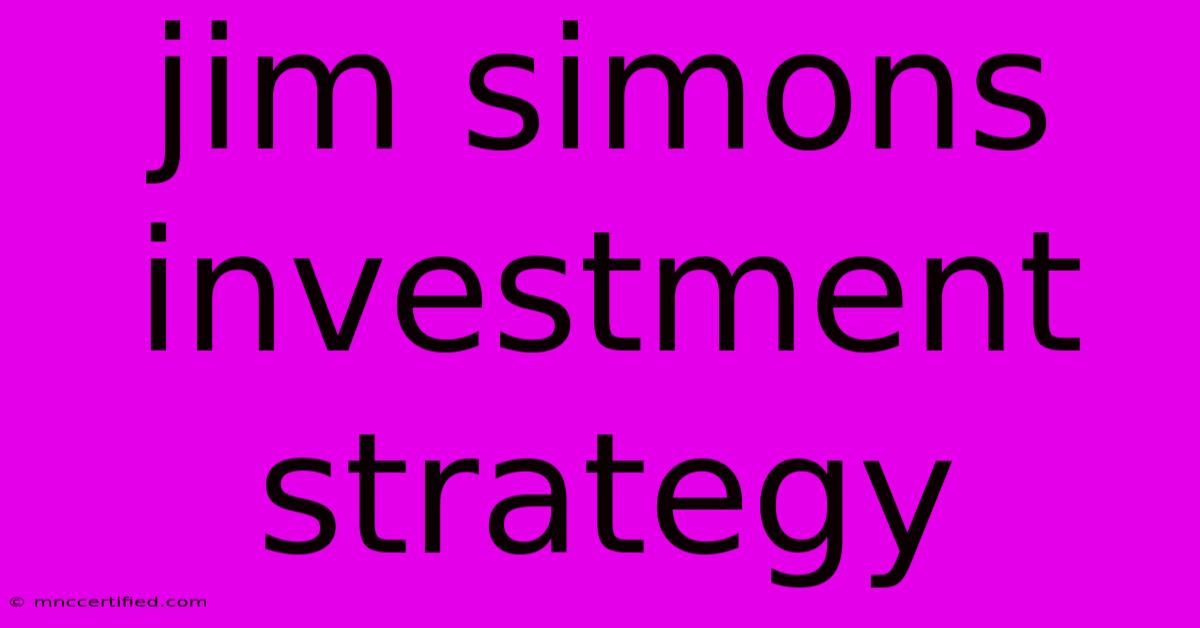Jim Simons Investment Strategy

Table of Contents
Jim Simons' Investment Strategy: A Deep Dive into Renaissance Technologies' Success
Jim Simons, the enigmatic founder of Renaissance Technologies, has achieved legendary status in the world of quantitative investing. His firm's remarkably consistent returns have captivated investors and academics alike, sparking intense curiosity about the methodologies behind its success. While the specifics of Renaissance Technologies' strategies remain closely guarded secrets, we can analyze publicly available information to understand the core principles underpinning Jim Simons' investment approach.
The Renaissance Technologies Methodology: A Blend of Math, Science, and Data
Simons' strategy deviates significantly from traditional fundamental or value investing. Instead, it relies heavily on quantitative analysis, employing advanced mathematical and statistical models to identify profitable trading opportunities. This approach, often referred to as quantitative trading (quant trading) or algorithmic trading, utilizes vast datasets and powerful computers to analyze market patterns and predict future price movements.
Key Pillars of Simons' Investment Strategy:
-
Emphasis on Data and Model Building: Renaissance Technologies employs a vast team of mathematicians, physicists, statisticians, and computer scientists to build sophisticated predictive models. These models analyze a wide range of data, including price movements, economic indicators, and even satellite imagery, searching for subtle correlations that might predict future market behavior.
-
Model Diversity and Portfolio Construction: Instead of relying on a single, all-encompassing model, Renaissance Technologies uses a diverse portfolio of models, each designed to exploit different market inefficiencies. This diversification helps mitigate risk and enhances overall portfolio performance. The firm's emphasis on statistical arbitrage involves exploiting temporary price discrepancies across different securities.
-
Adaptability and Continuous Improvement: The models used by Renaissance Technologies are not static. They are constantly refined and updated based on new data and market conditions. This adaptive approach is crucial for maintaining a competitive edge in a constantly evolving market.
-
Talent Acquisition: A crucial aspect of Renaissance Technologies' success is its ability to attract and retain top talent. Simons' firm recruits individuals with advanced degrees in mathematics, physics, and computer science, fostering a unique and highly skilled workforce.
-
Secrecy and Information Asymmetry: Renaissance Technologies is notoriously secretive about its specific investment strategies. This secrecy is a deliberate choice aimed at maintaining a competitive advantage by preventing others from replicating their successes.
Beyond the Models: The Cultural Aspects of Success
While the mathematical models are undoubtedly central to Renaissance Technologies' success, the firm's culture also plays a vital role. Simons fostered an environment of intellectual curiosity, collaboration, and meritocracy, attracting and retaining some of the brightest minds in the world. This collaborative, data-driven culture allows for the continuous development and improvement of trading strategies.
The Challenges and Criticisms of Simons' Approach
Despite its impressive track record, the Renaissance Technologies approach is not without its challenges and criticisms. The high computational costs and specialized expertise needed to implement such sophisticated strategies limit accessibility for smaller investors. Furthermore, the "black box" nature of the models makes it difficult to understand the rationale behind specific investment decisions, raising concerns about transparency and risk management. The historical success does not guarantee future performance and market shifts could impact its effectiveness.
Conclusion: Learning from the Master of Quantitative Investing
Jim Simons' investment strategy represents a paradigm shift in the world of finance, emphasizing mathematical modeling, data analysis, and a culture of continuous improvement. While the specifics of his firm's strategies remain undisclosed, the core principles – a focus on data, model diversity, and talent acquisition – offer valuable lessons for aspiring investors. However, it's crucial to recognize the limitations and challenges inherent in this approach. Its complexity and specialized expertise required make it unsuitable for most individual investors, though understanding the underlying principles can inform a broader investment philosophy. The success of Renaissance Technologies serves as a testament to the power of quantitative analysis in navigating the complexities of the financial markets.

Thank you for visiting our website wich cover about Jim Simons Investment Strategy. We hope the information provided has been useful to you. Feel free to contact us if you have any questions or need further assistance. See you next time and dont miss to bookmark.
Featured Posts
-
Disney Pin Trading Starter Set
Nov 28, 2024
-
Euro Millions Ticket Check A Blunder
Nov 28, 2024
-
Viper Accessories Trading Post
Nov 28, 2024
-
Hawaiian Airlines Diamond Head 2024 Airing
Nov 28, 2024
-
What Is An Investment Platform
Nov 28, 2024